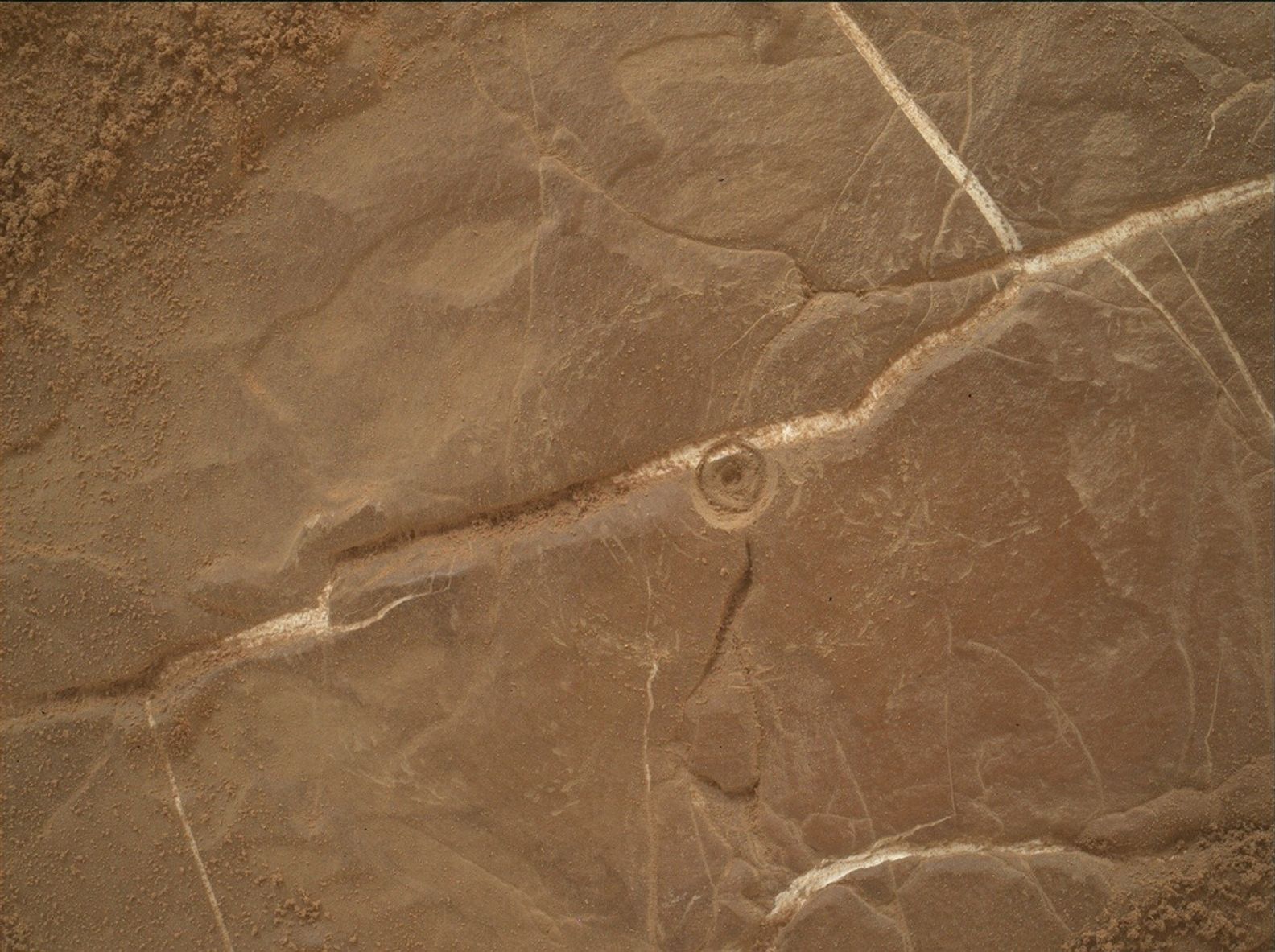4 min read
Sols 4561-4562: Prepping to Drill at Altadena NASA’s Mars rover Curiosity acquired this image of a recent DRT (Dust Removal Tool) site, showing off the marks created in the rocks by DRT — a motorized, wire-bristle brush on the turret at the end of the rover’s robotic arm — as well as a whitish vein that was revealed after the dust covering it was removed. Curiosity acquired this image using its Mars Hand Lens Imager (MAHLI), a camera mounted on the turret at the end of the robotic arm, which provides close-up views of the minerals, textures, and structures in Martian rocks and the surface layer of rocky debris and dust. Using an onboard process, MAHLI merges two to eight images to make a composite image of the same target acquired at different focus positions, to bring many features into focus in a single image. Curiosity merged this composite on June 4, 2025 — Sol 4560. Or Martian day 4,560 of the Mars Science Laboratory Mission — at 12:33:42 UTC. NASA/JPL-Caltech/MSSSWritten by Conor Hayes, Graduate Student at York University
Earth planning Wednesday, June 4, 2025
We are continuing to look for a suitable location to collect a drilled sample in this area. As you may recall from Monday’s plan, we performed a short “bump” of just under 4 meters (about 13 feet) hoping to find a drill target today after Monday’s analysis determined that there were no good targets in our previous workspace. Happily, today’s workspace was much more cooperative, and we were able to select the target “Altadena” as our next potential drill location. Altadena is a name that we’ve been saving for a special target, as its namesake here on Earth is a neighborhood next to JPL that was devastated by the Eaton Fire earlier this year. We’re about to enter our next mapping quadrangle, which will come with a new set of target names, so the team decided that using Altadena as the name for this drill site was an obvious choice.
The big activity in this plan is the next step in the drilling process. This activity is the “preload test,” which determines if the forces on the drill will be good while drilling, and the drill target won’t unexpectedly move or fracture. If we pass the preload test and find that the rock has the chemistry we’re looking for, we’ll be able to proceed with Altadena as our next drill site. If we don’t, we’ll have to decide whether to bump again or resume driving deeper into this potentially boxwork-bearing region.
Of course, the preload test isn’t the only thing we’re doing today. Coming in, it was looking like our time for other activities would be pretty tight due to power constraints imposed by preparations for drilling and keeping the rover warm during the cold Martian winter. However, we’ve recently implemented some new power-optimizing capabilities, which led to us having much more power today than we expected. This meant that we were able to add a whole additional hour of science time in addition to the hour that we already had scheduled.
Unsurprisingly, Altadena gets a lot of love in this plan to characterize it before we drill. This includes a ChemCam LIBS activity and a Mastcam observation, as well as some overnight observations by APXS and some MAHLI images. In addition, Mastcam will be observing some exposed stratigraphy at “Dana Point,” a light-toned vein at “Mission Trails” that will also be a ChemCam LIBS target, a few more nearby troughs, and a couple of sandy patches at “Camp Williams” to observe wind-driven sediment transport. Along with the two LIBS, ChemCam will be using its RMI camera to add to the pile of images we have of the Mishe Mokwa butte and the yardang unit off in the distance.
As the lead for the Atmosphere and Environment (ENV) group today, it looked like I was going to have a pretty light workload due to the power constraints preventing any ENV activities other than our usual REMS, RAD, and DAN observations. With the extra hour of science time, I was able to add a handful of new activities, including three Navcam cloud movies, a Navcam line-of-sight observation of dust within Gale Crater, and a Navcam survey to look for any dust devils that may be swirling around the rover. A pretty decent ENV science haul for a plan that started with nothing!
When we come into planning on Friday, we’ll hopefully have passed the preload test and will be able to turn Altadena into our 43rd drill hole in the coming sols, before we continue driving up the slopes of Mount Sharp.
Share
Details
Last Updated Jun 06, 2025Related Terms
BlogsExplore More
2 min readSearching for Ancient Rocks in the ‘Forlandet’ Flats
Article 1 hour ago3 min read
Sols 4559-4560: Drill Campaign — Searching for a Boxwork Bedrock Drill Site
Article 2 days ago2 min read
Sols 4556-4558: It’s All in a Day’s (box)Work
Article 3 days agoKeep Exploring
Discover More Topics From NASA
Mars
Mars is the fourth planet from the Sun, and the seventh largest. It’s the only planet we know of inhabited…
All Mars Resources
Explore this collection of Mars images, videos, resources, PDFs, and toolkits. Discover valuable content designed to inform, educate, and inspire,…
Rover Basics
Each robotic explorer sent to the Red Planet has its own unique capabilities driven by science. Many attributes of a…
Mars Exploration: Science Goals
The key to understanding the past, present or future potential for life on Mars can be found in NASA’s four…
Read More Details
Finally We wish PressBee provided you with enough information of ( Sols 4561-4562: Prepping to Drill at Altadena )
Also on site :
- Today’s NYT ‘Strands’ Hints, Spangram and Answers for Saturday, June 7
- Taylor Swift and Travis Kelce Dance At Surprising Backyard Wedding Appearance
- Ashley Tisdale Gives Her Review of Niece’s Performance of Sharpay in ‘High School Musical’ (Exclusive)

